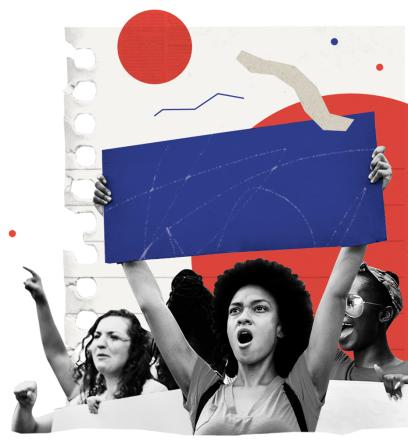Campus racial unrest is not a new phenomenon in US higher education. There are innumerable historical and contemporary examples, with many of the former stemming from the landmark struggles to admit and enroll Black students in predominantly white institutions. In modern times, there have been several major flashpoints related to racial unrest on US campuses, spanning institutional sizes, types, and sectors.1 A recent study of racially biased campus events analyzed 205 news-generating incidents on US campuses from 2005 to 2010.2 The six most common forms of racial bias across the events studied were graffiti or vandalism, the production and display of physical media with racially motivated messages, noose hangings, racially themed parties, verbal remarks, and assault or fighting.
In times of racial unrest, campus administrators often express surprise at the idea of racialized events on their campus. Presidential statements following racial incidents often highlight the misalignment of the sentiments expressed by the perpetrators of the incident and the values and norms of the campus community.3 Analyses of these statements4 reveal that language denouncing racism or linking racist behavior and sentiments to the systemic and historical roots of racism is not included. Some presidential statements following racial incidents do not even make mention of the incidents to which they are a response.5
Inherent in these presidential statements is a belief that by establishing community norms—often through guiding philosophies such as an institutional mission or a code of conduct—incidents that are antithetical to the established norms should be effectively prevented. Establishing community norms of inclusivity and espousing an institutional value on diversity is but one step toward mitigating discriminatory events on campus; it is not a stand-alone preventative measure. Mitigating racial incidents on campus requires the same level of anticipation, monitoring, and attention, as does enrollment management, course registration, fundraising, or any other operational procedure.
Proactive crisis management begins with identifying signal detection mechanisms as related to identity. One such signal would include any data collected on campus climate. Campus climate data often reveal areas where (1) the campus community falls short of established norms and expectations of conduct and engagement with people holding historically marginalized identities; and (2) the campus environment is experienced as unwelcoming, marginalizing, or alienating.
Racial unrest on campus can be the result of either an active threat to the campus community or the news of a past racist incident or event. Recovery and healing for a campus community can be quite an unwieldy process. The emotional bleeding triggered by a racial incident may appear stabilized by the crisis response, but it often leaves an open wound that runs the risk of being reactivated by the smallest puncture in the campus racial dynamics. Although there is no set checklist, we offer suggestions for some potential steps along the pathway forward after a campus has been touched by racial unrest (and we offer a detailed discussion of these strategies in chapter 7 of Campus Uprisings).
- Provide space and resources for the campus to process and heal.
- Establish or intensify a focus on the campus climate.
- Take lessons from higher education history and institutional peers.
- Develop a sophisticated response plan for racial incidents (including proactively accounting for the resources, and completing any training, required to respond appropriately).
Higher education presidents need to ensure proactive monitoring of their campus racial climates and develop their confidence and competence both to eliminate campus policies, environments, and cultures that may incubate racial tensions and to swiftly and authentically respond to racialized incidents. Presidents and their cabinets should routinely conduct tabletop drills in which they use recent events from other institutions to talk through their own response concerns and process. Taking steps to establish systems with the flexibility to respond to unique incidents and prepare themselves to lead in the midst of crisis will help college and university presidents keep their institutions on a forward path.
Mahauganee Shaw Bonds is an independent scholar and consultant. Through her scholarship and her work with Buoyant Consulting LLC, she helps higher education professionals to effectively mitigate, manage, and move through times of crisis and change while maintaining organizational buoyancy. Sydney Freeman, Jr., is an associate professor of Adult, Organizational Learning and Leadership at the University of Idaho. His research investigates the challenges facing higher education administration programs, specifically higher education as a field of study and the university presidency.
This adapted selection is reprinted by permission of the Publisher. From Ty-Ron M. O. Douglas, et al., eds., Campus Uprisings: How Student Activists and Collegiate Leaders Resist Racism and Create Hope, New York: Teachers College Press. Copyright © 2020 by Teachers College, Columbia University. All rights reserved.
To read more from Campus Uprisings, see "Introducing Campus Uprisings" and "Racial Breakthroughs: Born of Student Protest."
Endnotes
1. E. Cole and S. Harper, “Race and Rhetoric: An Analysis of College Presidents’ Statements on Campus Racial Incidents,” Journal of Diversity in Higher Education 10, no. 4 (2017): 318-333; S. Davis and J. Harris, “But We Didn’t Mean it Like That: A Critical Race Analysis of Campus Responses to Racial Incidents,” Journal of Critical Scholarship on Higher Education and Student Affairs 2, no. 1 (September 2015): 62-78; G. García and M. Johnston-Guerrero, “Challenging the Utility of a Racial Microaggressions Framework Through a Systematic Review of Racially Biased Incidents on Campus,” Journal of Critical Scholarship on Higher Education and Student Affairs 2, no. 1 (2015): 49-66; G. García et al., “When Parties Become Racialized: Deconstructing Racially Themed Parties,” Journal of Student Affairs Research and Practice 48, no. 1 (2011): 5-21.
2. García and Johnston-Guerrero, “Challenging the Utility of a Racial Microaggressions,” 49-66.
3. Cole and Harper, “Race and Rhetoric,” 318-333.
4. Cole and Harper, “Race and Rhetoric,” 318-333; Davis and Harris, “But We Didn’t Mean it Like That,” 62-78.
5. Cole and Harper, “Race and Rhetoric,” 318-333.
[Illustration by Lucy Naland, photos: Getty Images]

